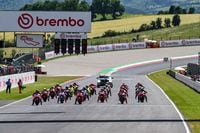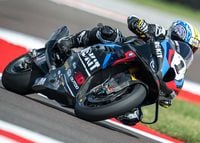
Risk tolerance. Aversion to pain. Monetary budgets. Those are probably the three reasons you don’t go faster around the track, or why you have stayed away from the track. This Ienatsch Tuesday sheds light on how you can go faster, but more importantly, stay safer while running respectable lap times. For those “Track Curious” riders, here are two techniques that will help you enjoy your first track day immensely.
Let’s discuss two proven techniques to lowering your lap times while maintaining or even reducing your risk. The street application has much less to do with the “lowering your lap times” than it does with the “reducing your risk” part of the previous sentence!
1-Where are you coasting? Where have you closed the throttle and not used the brakes, or let go of the brakes and not picked up the throttle? You should be able to answer those two questions right now, on whatever track(s) you run. Think of coasting as inefficient, and increasing efficiency almost always leads to better performance.
Let’s look at the first one: You close the throttle and don’t need the brakes, and you make the corner “just fine.” Think about carrying the throttle longer, and when you close it, squeeze on the brakes. Think about using more throttle in the area just before the corner. Longer throttle and more throttle, offset by more brakes.

Sitting there right now, think of the corners you are entering sans brakes, closing the throttle early and letting the engine slow you down. That’s extremely inefficient, and not adjustable. More throttle, more brakes.
Two years , Ken Hill and I worked with an insanely fast rider on a full-race Triumph 675 at Carolina Motorsports Park. He was entering the right hander before the downill back straight without brakes. We got him to accelerate longer into the corner, squeeze on a little brake, and he dropped seven-tenths of a second on a track he had ridden for years. He loved us because seven-tenths was a massive improvement for a guy that quick.
Now the second scenario: You’ve let go of the brakes but aren’t at a point in the corner to pick up the throttle. I know what you’re thinking: I need to brake later. Yes, possibly. But how about this: You need to brake lighter, longer. Pull the brakes on at the point you want (where you get nervous), but don’t squeeze them so dang hard. Your speed will stay higher, longer, but you will be “in control” of your speed and geometry. As you work within this proven technique, you will be using the brakes longer, reducing your coasting time, increasing efficiency, and reducing lap times. Your tire loading will be more consistent, and your risk will diminish.
2-Where do you have track left over? That means early (tight) entrances, missed apexes, low (tight) exits. And before you think you’re doing a good job, my instructors at the Yamaha Champions Riding School estimate that eight out of 10 trackday riders do not use the track correctly. Eighty percent of the trackday riders we see are off-line at some point during their lap!

Last month, I ran my Yamaha FZ1 for some two-up laps at a trackday, giving rides to some VIPs. They put me in the Intermediate Group and I did not see one good apex in three sessions during those two-up laps. One-hundred percent of the riders I passed need to read this article and apply these words.
Keep this simple equation in mind: Radius Equals Speed. That will get you thinking about lines, opening up entrances, maximizing exits, getting right up against the apex curbing. Watch MotoGP, SBK, AMA/MotoAmerica and apply what you see to your particular track.
Let’s change that equation: Radius Equals Safety. The more radius you can run, the less lean angle you need. If you run less lean angle, you can run more throttle and brakes, taking into account that a tire only has 100 percent (100 points) of its grip available. Points of grip is what this sport is about, and your “bad” lines are keeping you too close to 100 points of grip, yet you are not setting the class’ lap record.
A low (tight) entry forces you to add lean angle quicker, and that means you must trail off braking points quicker. Open up (widen) this entrance and you can turn in more gradually, and use more brake points longer. Tight entry lines force the rider to do one of two things: lean over farther or slow down. That means more risk and a worse lap time. We want to be faster and safer, not slower and riskier.
A low (tight) exit holds lean angle points and that means fewer acceleration points are available. You will spin the tire (and eventually highside) sooner than the rider who maximizes the exit. You need to jump your eyes off the apex sooner and stand the bike up earlier. As you take away lean angle points, you get to add throttle points. You will be faster and safer.

Missing apexes puts you on a more-narrow track than those who are nailing their apexes and that means you have to run more lean angle for a given lap time. Riders hitting their apexes are running quicker lap times with less risk.
Get your brain going right now about your next trackday. Get out your notebook (you have a notebook, right? Mat Mladin did) and draw the corners, make notes regarding these two proven techniques to lowering your lap time. Get efficient in your control and track use to become faster and safer.
Street riders: To get your brain around more of this type of riding-technique talk and the techniques taught at the Yamaha Champions Riding School, check out Nick’s “The Pace 2.0” and “The Brake Light Initiative.”
More next Tuesday!
/cloudfront-us-east-1.images.arcpublishing.com/octane/DS3Q5X2VJFFAJDK2PWB3Y7K6U4.jpg)
/cloudfront-us-east-1.images.arcpublishing.com/octane/4KBL4JAMYRFDPEINTWATDUH7OM.jpg)
/cloudfront-us-east-1.images.arcpublishing.com/octane/FXADK3MVSNBRTKJ2B7TPDCCJ5Y.jpg)
/cloudfront-us-east-1.images.arcpublishing.com/octane/M7L2CPXO55FRFMECW7QGDPGP6E.jpg)
/cloudfront-us-east-1.images.arcpublishing.com/octane/T4RWGLAEHVE2VCJZOTFTNGB2KA.jpg)
/cloudfront-us-east-1.images.arcpublishing.com/octane/JM4QGLAHWNGHPM74OEB7FVBFSY.jpg)
/cloudfront-us-east-1.images.arcpublishing.com/octane/BGPNXPDDYBHD3HL6YEZQOYHXTI.jpg)
/cloudfront-us-east-1.images.arcpublishing.com/octane/SND5GGQV4RDPPMZBSBEGIZ4SIY.jpg)
/cloudfront-us-east-1.images.arcpublishing.com/octane/XUDDAPYZMZEL5EDPVDJ2DTULWI.jpg)
/cloudfront-us-east-1.images.arcpublishing.com/octane/M7AU2L6GAVCJVHW57LIRPDAAUQ.jpg)

/cloudfront-us-east-1.images.arcpublishing.com/octane/JKEJY7P43JGD5C5NJO2VJQJPUM.jpg)
/cloudfront-us-east-1.images.arcpublishing.com/octane/YROKYJYUQVGPHCEMPTGBWDQCKQ.jpg)
/cloudfront-us-east-1.images.arcpublishing.com/octane/QIHEYR66TZDAPCGMWHCWCBC4XA.jpg)
/cloudfront-us-east-1.images.arcpublishing.com/octane/4FTBMNZL5BD2ZHY62XXRHJW6PI.jpg)
/cloudfront-us-east-1.images.arcpublishing.com/octane/L2BHKRCEMFDF7O3S4REZXPDH2E.jpg)
/cloudfront-us-east-1.images.arcpublishing.com/octane/QHENIV3HMJCTTCXQ6O5YPTNRZ4.jpg)
/cloudfront-us-east-1.images.arcpublishing.com/octane/K3VNQBIAKVGIHIGBRG7QKJYLVI.jpg)
/cloudfront-us-east-1.images.arcpublishing.com/octane/HRU64QXT3NH2DJOFBVI53XIKCE.jpg)
/cloudfront-us-east-1.images.arcpublishing.com/octane/4C5HHSNJCVDZXPIJTCJBVTE2MU.jpg)
/cloudfront-us-east-1.images.arcpublishing.com/octane/HBKK2TCOCZFIBIVKLKZFF5NXLQ.jpg)
/cloudfront-us-east-1.images.arcpublishing.com/octane/23S5ZEY2FBBADHQQK7AKLFDNYM.jpg)
/cloudfront-us-east-1.images.arcpublishing.com/octane/OPF3CNKKLVAN3AHQWD22DPWLEQ.jpg)
